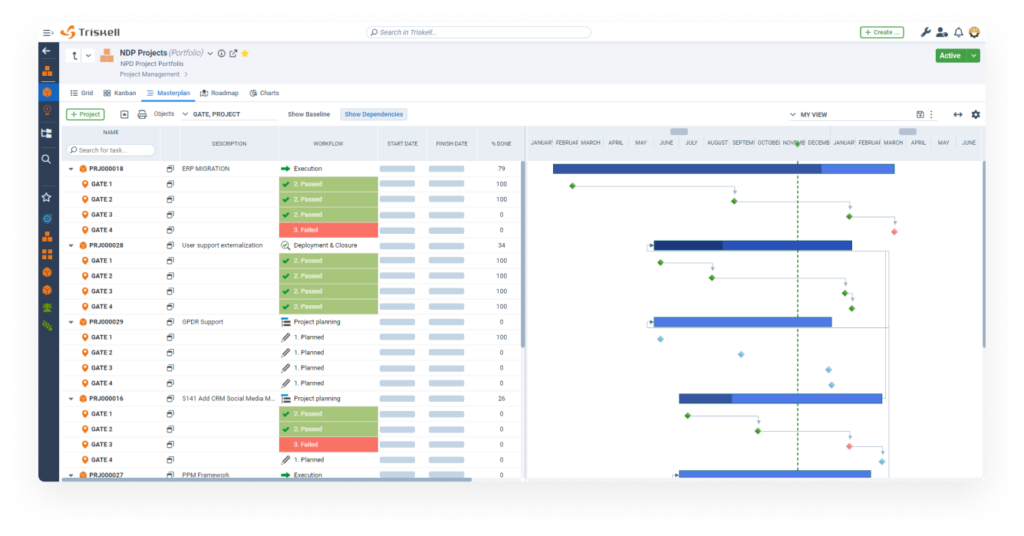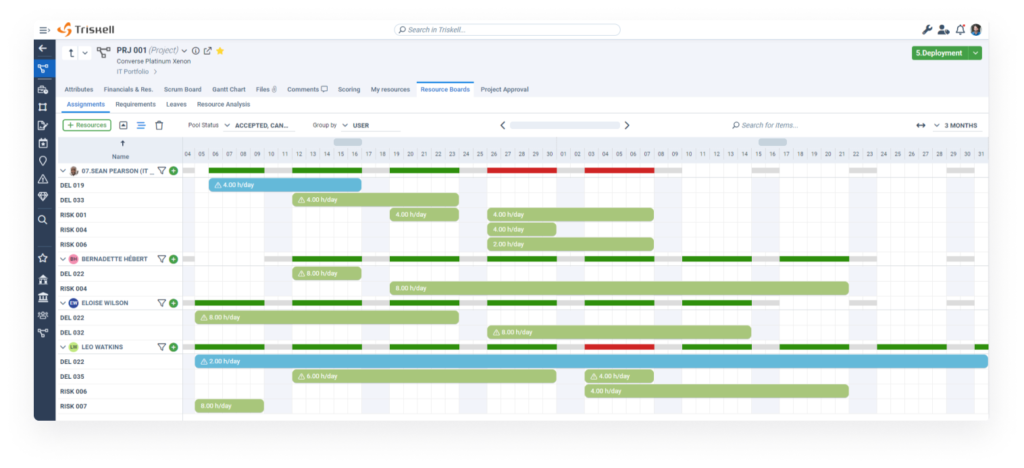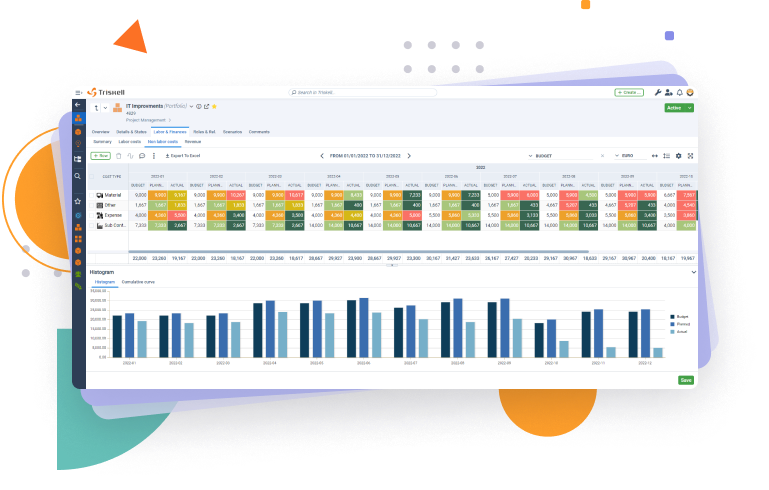
How to create a project budget: methods and techniques for effective project budgeting
Learn how to create a project budget with this detailed guide. Discover essential methods and techniques for effective project budgeting in PPM.

Project portfolio management has become a strategic element for businesses. More and more organizations are having a PMO in place, that serves as a guide and support to Project Managers throughout the lifecycle of each of the projects and programs they manage.
As organizations have had to evolve their management and operations models towards other more agile approaches, PMOs will also have to evolve if they do not want to run the risk of being stuck in the past, and that company management no longer perceives the value they can bring to the organization. From Triskell Software we explain the seven challenges that PMOs must face in this new environment in order to take them to the next level.
TABLE OF CONTENTS
Traditionally, PMOs have based their operations on keeping control of projects, so that they are completed on time and on budget. However, today, with increasingly complex and changing competitive environments, agile management is gradually taking over from more traditional ways of management, PMOs that remain anchored in this “classic” management model are in danger of disappearing if they do not set these objectives:

PMO MANAGEMENT
Improve project visibility and overcome data silos
Find out how PMOs can leverage Triskell Software PPM solutions.
Organizations are now focused on the value they deliver to their customers, and how the different areas and departments participate in the creation of that value. If PMOs remain stuck in their command and control model to ensure that projects are delivered on time and on budget, their contribution to the value streams of the organization will be marginal and, therefore, will be considered by senior management as an unnecessary expense for the company.
Agile and collaborative environments are gaining ground over silo-based organizational models. PMOs must evolve and stop being just the office where Project Managers have the necessary tools to carry out the organization’s projects.
PMOs must, on the one hand, seek continuous communication flows with the company’s Senior Management in order to align the Project Portfolio with the organization’s objectives. And, on the other hand, to serve as a reference point both for stakeholders and for the work teams involved in the projects, offering them both real-time information on the status of projects and support at all levels for their correct implementation.
In this new competitive environment, with highly volatile markets that require companies to bring products and services to market as quickly as possible, change is the norm. Company objectives can change in very short periods of time, which makes it necessary to redesign the prioritization of the project portfolio.
SUBSCRIBE TO OUR NEWSLETTER
Get stories like this in your inbox
This is where PMOs have to adapt to this new environment and manage in an agile manner key project management issues such as prioritization, resource management, budgets or delivery dates, and learn to react to changes that may arise in their project portfolios in an agile and efficient manner without losing sight of the organization’s objectives.
Renew or die. That’s the point. If PMOs do not set these three objectives mentioned above, will be at risk of disappearing because senior management will no longer perceive the value they bring to the organization.
It won´t be easy, and along the way, the Project Management Office will have to face several challenges to cope with this transformation to the new reality. Specifically, there are seven challenges that the PMO will have to deal with in order for its role to be perceived as key to the organization’s value streams:
Next, we go on to detail each of these challenges and how the PMO must face them.
Many companies fail to achieve their strategic objectives precisely because the execution of their project portfolio was not aligned with the organization’s strategy. PMOs must be conscious of the importance to the business of executing programs and projects that are aligned with the organization’s mission and vision.

PROJECT PORTFOLIO MANAGEMENT
Make informed decisions and prioritize effectively
Learn more about Triskell’s PPM solution.
To this purpose, the PMO must play a crucial role in the strategy execution, maintaining regular communication channels with Senior Management to ensure that the portfolio is aligned with the organization’s objectives. This should be reflected in product and project portfolios that are more in line with the medium- and long-term vision of the business, and teams and work areas focused on achieving common objectives.
The biggest challenge that Project Management Offices have to face on a daily basis, and also the main reason why many of them fail, is to efficiently manage resources across their project portfolio.
At this point, PMOs may face several problems as a result of poor resource planning. For example, having unrealistic schedules and budgets, inefficient time management, or inconsistent resource allocations.
Problems related to resource management can be prevented if the PMO has a clear vision of the organization’s strategic objectives. as explained in the previous point. Having a communication channel always opened with Senior Management will ensure that the execution of the Project Portfolio is aligned with the strategic planning and, therefore, financial and human resources management in accordance with the organization’s objectives.
See how to overcome all these challenges with Triskell
Request a demo today and discover how Triskell provide all the tools to improve visibility, prioritize effectively, and ensure project success.
Change management is another of the trickiest aspects that a PMO must face when executing the project portfolio. Either because the organization’s objectives change, or also because new demands come to the PMO that end up being more projects to manage, the truth is that in many occasions PMOs have problems in managing these changes, either because they fail to reallocate resources or because they fail to prioritize projects.
Here again, communication is essential. Firstly, with senior management, to ensure that any readjustments made when changing portfolio priorities are in line with strategic planning. And, secondly, with the teams and work areas involved in the organization’s value streams, so that all of them work in an agile way and prioritize their backlogs according to what the organization needs at that moment.
As previously explained, the PMO must have open and constant communication channels with the organization’s managers to ensure that strategic planning and project portfolio execution are aligned.
And not only that. PMOs must ensure that senior management sees the value they create for the organization. This communication should also include reports and dashboards that inform in real-time the status of each of the projects, as well as the main milestones achieved throughout the portfolio execution.
On this path that many organizations are taking towards business agility, PMOs must act as one of the leaders of change. It must evolve from being an office from which to control the status of the portfolio execution and give the corresponding orders to the different work teams, to act as a facilitator and help remove obstacles and bottlenecks that may obstruct the execution of the portfolio.
In other words, the PMO must also embrace Agile Leadership. They must leave behind the traditional management based on Command&Control, and be a support point so that Project Managers and the different teams and work areas can perform their work to their full potential.
WEBINAR
Innovate and Elevate: Top PMO Trends for 2024
Another challenge that PMOs must face is that, during portfolio execution, project managers and teams have processes in place that may cause bottlenecks in project workflows and, therefore, therefore obstruct and slow down the progress of the project.
The PMO should strive to identify these gaps and collaborate with all parties involved in the project portfolio to design standardized processes and workflows involved in the project portfolio, which must be shared with both the Project Managers and the teams and departments involved in the organization’s projects.
Many PMOs need to renew the suite of tools they use to manage and monitor the project portfolio. It has already been proven that Excel is not the best choice for project portfolio management, although many still use it to monitor the status of projects and inform senior management about their status.
Other PMOs do have PPM software with functionalities that allow them to manage and monitor the portfolio. However, many of these solutions do not offer the possibility of visualizing, from a single interface, the strategic planning with the execution of the project portfolio. Therefore, PMOs will continue to have problems in carrying out a correct prioritization of projects or a realistic allocation of resources, among other issues.your

If you want your PMO to have a complete view of both strategic planning and project portfolio execution, Triskell Software is the PPM software you are looking for.
With Triskell you will get support for the 7 challenges mentioned above, and both PMO and Project Managers will instantly benefit from the functionalities with our PPM solution. For example, all of them will be able to:

SUBSCRIBE TO OUR NEWSLETTER
Get stories like this in your inbox
Request a demo of Triskell Software
Triskell meets all the requirements for your organization’s PMO to take a step forward in aligning your project portfolio with strategic planning.

PMOs typically struggle with aligning project portfolios with the organization’s strategy, effectively managing resources, adapting to project portfolio changes, and communicating clearly with senior management. Additionally, embracing agile leadership, standardizing processes, and keeping PM tools up-to-date can pose significant challenges.
Resistance to change is a common hurdle. Focus on clear communication, highlighting the benefits the PMO brings to project success and overall organizational efficiency. Demonstrate value early on with small wins and involve stakeholders in the process to create a sense of ownership.
Resource management is a constant challenge. Utilize resource planning tools, conduct skills assessments to identify gaps, and implement workload forecasting to anticipate future needs. Promote flexibility and cross-training among team members to optimize resource allocation.
The PMO landscape is constantly evolving. Regularly evaluate your PPM tools to ensure they align with current needs. Stay updated on industry trends, be open to adopting new technologies like AI and automation, and encourage a culture of continuous improvement within the PMO.
By addressing these common PMO challenges and adopting the suggested solutions, your PMO can become a strategic asset, driving successful project execution and contributing to overall organizational growth.
Related Content

How to create a project budget: methods and techniques for effective project budgeting
Learn how to create a project budget with this detailed guide. Discover essential methods and techniques for effective project budgeting in PPM.

20 strategic planning models and tools for medium and large companies
Looking for the best strategic planning frameworks? This guide covers 20 proven models to enhance decision-making and business growth.

The ultimate guide to Scenario Analysis for PPM: how it works, examples, techniques and tools
Master scenario analysis for PPM. Discover how to apply scenario planning for resource management, budgeting, and strategic decision-making.
Solutions
Platform
Company
Compare Triskell
© 2025 Triskell Software. All Rights Reserved.
Legal Notice
Privacy Policy
Cookies policy
Quality Management and Information Security System Policy

We use technologies such as cookies to store and/or access device information. We do this to improve the browsing experience and to display (non-) personalized advertisements. Consenting to these technologies will allow us to process data such as browsing behavior or unique ID's on this site. Not consenting, or withdrawing consent, may adversely affect certain features and functions.